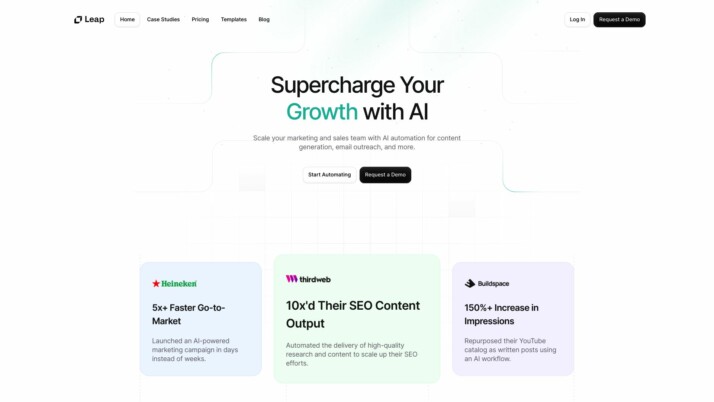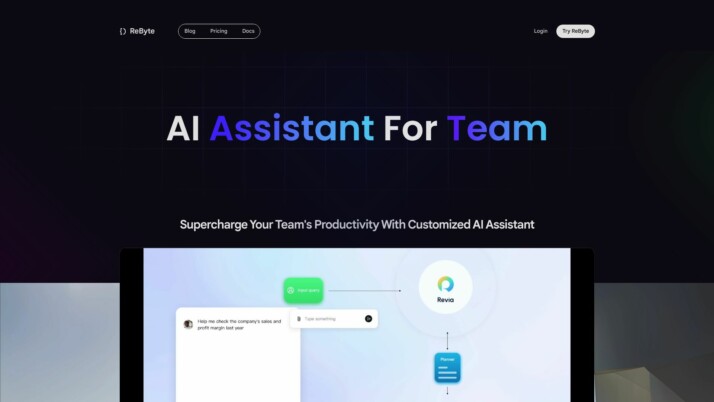Leap AI vs. Rebyte: Comparing AI Development Platforms
AI platform selection can significantly impact business operations and innovation capabilities. This comparison examines Leap AI vs. Rebyte, and SmythOS, three platforms reshaping AI development and deployment. Leap AI offers no-code AI workflow creation, while Rebyte focuses on visual agent building. SmythOS emerges as a comprehensive solution, addressing limitations of both alternatives with advanced features like autonomous agents and constrained alignment. We’ll explore each platform’s strengths, weaknesses, and unique offerings to help you determine the best fit for your AI development needs, whether you’re a developer seeking robust APIs, a business leader focused on scalability, or a non-technical user looking for accessible AI tools.
Leap AI Overview
Leap AI empowers users to create sophisticated AI workflows without coding expertise. This platform combines a visual drag-and-drop interface with powerful AI capabilities, making it accessible to both technical and non-technical users. Leap AI integrates seamlessly with popular tools like Slack, HubSpot, and Zapier, enabling businesses to enhance their existing processes with AI.
The platform’s strength lies in its versatility. Users can leverage pre-built templates to quickly deploy AI solutions for tasks ranging from content generation to customer support automation. For those requiring more customization, Leap AI offers multiple SDKs and a RESTful API, allowing developers to integrate its capabilities into their own applications.
Leap AI empowers users to create sophisticated AI workflows without coding expertise… making it accessible to both technical and non-technical users.
Leap AI stands out for its support of various AI models, including OpenAI GPT, Mistral 7b, and Stable Diffusion XL. This diversity enables users to select the most appropriate model for their specific use case, whether it’s text generation, image creation, or even music composition. The platform also offers AI model training capabilities, allowing businesses to fine-tune models on their own datasets for improved accuracy and relevance.


Screenshot of Leap AI Website
While Leap AI excels in many areas, it does have limitations. The platform lacks some advanced features like autonomous agents and constrained alignment, which may be crucial for certain enterprise-level applications. Additionally, there’s no mention of a hosted vector database or specific support for PDF and Word file processing, which could limit its utility in document-heavy workflows.
Despite these constraints, Leap AI’s user-friendly approach to AI implementation makes it a compelling choice for businesses looking to harness the power of AI without significant technical overhead. Its focus on integration and customization allows for scalable solutions that can grow with an organization’s needs.
Rebyte Overview
Rebyte empowers users to rapidly create AI-powered applications without extensive coding expertise. The platform’s visual agent builder enables construction of complex AI agents through a multi-step process leveraging large language models. Users can craft fully customized user interfaces for their agents without writing code, while also integrating private data sources.
Rebyte provides detailed observability into every stage of an agent’s operation, offering insights crucial for optimization and troubleshooting. The platform’s serverless runtime is engineered for seamless production deployment and scalability of agents, ensuring robust performance as applications grow.
Rebyte empowers users to rapidly create AI-powered applications without extensive coding expertise. The platform’s visual agent builder enables construction of complex AI agents…


Screenshot of Rebyte Website
Rebyte’s vision centers on democratizing AI-powered tool development. By providing a comprehensive platform that handles hosting, orchestration, testing, and deployment of AI agents, Rebyte aims to enable knowledge workers and teams to automate workflows and enhance productivity through intuitive no-code interfaces.
Rebyte’s vision centers on democratizing AI-powered tool development… Rebyte aims to enable knowledge workers and teams to automate workflows and enhance productivity…
The platform’s key differentiators include its visual agent builder, integrated runtime, and focus on end-user programming through AI. Rebyte manages the entire lifecycle of AI applications with minimal manual coding required. This approach aligns with the growing trend of accessible AI development, allowing users to transform ideas into deployed applications simply by describing their requirements.
While Rebyte offers powerful capabilities for AI agent creation, it lacks some advanced features found in other platforms. The absence of hosted vector databases and limited support for multimodal interactions may restrict its applicability in certain complex scenarios. Additionally, the platform’s focus on simplicity may come at the cost of some advanced customization options that experienced developers might seek.
Feature Comparison
Leap AI and Rebyte offer distinct approaches to AI agent development, with notable feature gaps in key areas. Leap AI provides a user-friendly platform for creating AI workflows without coding, integrating popular AI models like OpenAI GPT and Stable Diffusion XL. However, it lacks autonomous agent capabilities and constrained alignment features, which may limit its utility for complex enterprise applications.
Rebyte, on the other hand, focuses on rapid AI application development through its visual agent builder and serverless runtime. While it excels in customizable user interfaces and detailed observability, Rebyte falls short in offering a hosted vector database and has limited support for multimodal interactions. This gap could restrict its effectiveness in scenarios requiring sophisticated data management or diverse input processing.
In terms of core components, SmythOS stands out by offering a comprehensive suite of features absent in both Leap AI and Rebyte. Our platform provides autonomous agents, constrained alignment, and a hosted vector database, addressing critical needs for advanced AI implementations. SmythOS also offers superior security features, including data encryption and OAuth integration, ensuring robust protection for AI applications in production environments.
Feature Comparison Table
| Leap AI | Rebyte | SmythOS | |
|---|---|---|---|
| CORE FEATURES | |||
| Hosted Agents (Dev, Production) | ❌ | ✅ | ✅ |
| Autonomous Agents | ❌ | ❌ | ✅ |
| Explainability & Transparency | ❌ | ✅ | ✅ |
| Debug Tools | ❌ | ✅ | ✅ |
| Multimodal | ✅ | ❌ | ✅ |
| Multi-Agent Collaboration | ❌ | ❌ | ✅ |
| SECURITY | |||
| Constrained Alignment | ❌ | ❌ | ✅ |
| Data Encryption | ✅ | ❌ | ✅ |
| OAuth | ✅ | ❌ | ✅ |
| IP Control | ✅ | ❌ | ✅ |
| COMPONENTS | |||
| Huggingface AIs | ✅ | ❌ | ✅ |
| Classifiers | ✅ | ❌ | ✅ |
| Logic | ✅ | ❌ | ✅ |
| Data Lakes | ❌ | ❌ | ✅ |
| DEPLOYMENT OPTIONS (EMBODIMENTS) | |||
| Deploy as Webhook | ✅ | ❌ | ✅ |
| Staging Domains | ✅ | ❌ | ✅ |
| Production Domains | ✅ | ❌ | ✅ |
| API Authentication (OAuth + Key) | ✅ | ❌ | ✅ |
| Deploy as Scheduled Agent | ✅ | ❌ | ✅ |
| DATA LAKE SUPPORT | |||
| Hosted Vector Database | ❌ | ✅ | ✅ |
| Sitemap Crawler | ✅ | ❌ | ✅ |
| YouTube Transcript Crawler | ✅ | ❌ | ✅ |
| URL Crawler | ✅ | ❌ | ✅ |
Best Alternative to Leap AI and Rebyte
SmythOS stands out as the superior alternative to Leap AI and Rebyte, offering a comprehensive platform for AI agent development and deployment. Our solution addresses critical gaps in both competitors’ offerings, providing a robust set of features that cater to diverse AI implementation needs.
Unlike Leap AI and Rebyte, SmythOS excels in autonomous agent capabilities, allowing users to create AI systems that operate independently with minimal human intervention. This feature significantly enhances productivity and enables the automation of complex tasks across various industries.
SmythOS excels in autonomous agent capabilities, allowing users to create AI systems that operate independently with minimal human intervention.
SmythOS outperforms both competitors in terms of security and compliance. We implement advanced data encryption, OAuth integration, and IP control measures, ensuring that AI applications meet stringent enterprise-level security requirements. This makes SmythOS ideal for businesses handling sensitive data or operating in regulated industries.
Our platform’s versatility shines through its extensive integration ecosystem and deployment options. SmythOS supports a wide range of AI models, including those from Hugging Face, and offers seamless integration with popular APIs and services. Users can deploy AI agents as APIs, webhooks, scheduled tasks, or even as chatbots, providing unparalleled flexibility in how AI solutions are implemented and utilized.
With SmythOS, users benefit from a powerful combination of user-friendly design and advanced capabilities. Our visual builder and no-code options make AI development accessible to users of all skill levels, while still offering the depth and customization options that experienced developers demand. This balance ensures that SmythOS can scale with your needs, from simple automation tasks to complex, enterprise-wide AI implementations.
Conclusion
Leap AI and Rebyte offer unique approaches to AI agent development, each with strengths and limitations. Leap AI excels in no-code AI workflow creation and integration with popular tools, while Rebyte shines with its visual agent builder and serverless runtime. However, both platforms lack critical features for complex enterprise applications.
SmythOS emerges as the superior choice, addressing the limitations of Leap AI and Rebyte while offering a comprehensive suite of advanced features. Our platform provides autonomous agents, constrained alignment, and a hosted vector database—essential components absent in the alternatives. SmythOS also prioritizes security with data encryption and OAuth integration, ensuring robust protection for AI applications in production environments.
Our drag-and-drop interface simplifies AI workflow creation, allowing users to harness over 300,000 integrations effortlessly. This extensive ecosystem empowers businesses to orchestrate complex workflows and combine various AI models, APIs, and data sources with unprecedented ease.
SmythOS stands out with its ’Create Once, Deploy Anywhere’ approach, enabling seamless integration of AI agents across multiple platforms. Whether you need to deploy agents as APIs, chatbots, or scheduled tasks, our platform offers unparalleled flexibility and scalability.
Explore our diverse range of AI-powered agent templates to jumpstart your projects and revolutionize your workflow. With SmythOS, you’re not just adopting an AI platform—you’re future-proofing your business. Experience the power of SmythOS today and transform your approach to AI development. Get started with SmythOS and unlock the full potential of AI for your organization.
Last updated:
Disclaimer: The information presented in this article is for general informational purposes only and is provided as is. While we strive to keep the content up-to-date and accurate, we make no representations or warranties of any kind, express or implied, about the completeness, accuracy, reliability, suitability, or availability of the information contained in this article.
Any reliance you place on such information is strictly at your own risk. We reserve the right to make additions, deletions, or modifications to the contents of this article at any time without prior notice.
In no event will we be liable for any loss or damage including without limitation, indirect or consequential loss or damage, or any loss or damage whatsoever arising from loss of data, profits, or any other loss not specified herein arising out of, or in connection with, the use of this article.
Despite our best efforts, this article may contain oversights, errors, or omissions. If you notice any inaccuracies or have concerns about the content, please report them through our content feedback form. Your input helps us maintain the quality and reliability of our information.
